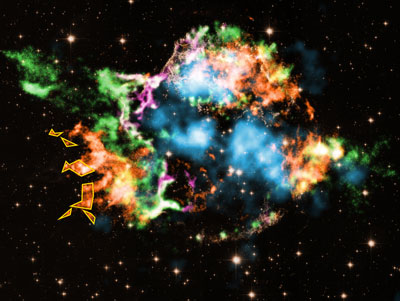Jul. 28, 2021 Research Highlight Physics / Astronomy
Smoking-gun evidence for neutrinos’ role in supernova explosions
Supernova explosions are sustained by neutrinos from neutron stars, a new observation suggests
 Figure 1: The Cassiopeia A supernova remnant has iron-rich plumes that contain titanium and chromium (areas with thick yellow outlines on right). This observation provides support for a model in which neutrinos help drive supernova explosions. © 2021 NASA/CXC/RIKEN/T. Sato et al.; NuSTAR: NASA/NuSTAR
Figure 1: The Cassiopeia A supernova remnant has iron-rich plumes that contain titanium and chromium (areas with thick yellow outlines on right). This observation provides support for a model in which neutrinos help drive supernova explosions. © 2021 NASA/CXC/RIKEN/T. Sato et al.; NuSTAR: NASA/NuSTAR
A model for supernova explosions first proposed in the 1980s has received strong support from the observation by RIKEN astrophysicists of titanium-rich plumes emanating from a remnant of such an explosion1.
Some supernova explosions are the death throes of stars that are at least eight times more massive than our Sun. They are one of the most cataclysmic events in the Universe, unleashing as much energy in a few seconds as the Sun will generate in 10 billion years.
In contrast, neutrinos are among the most ethereal of members of the elementary-particle zoo—they are at least 5 million times lighter than an electron and about 10 quadrillion of them flit through your body every second without interacting with it.
It’s hard to conceive that there could be any connection between supernovas and neutrinos, but a model advanced in the 1980s proposed that supernovas would not occur if it were not for the heating provided by neutrinos.
This type of supernova starts when the core of a massive star collapses into a neutron star—an incredibly dense star that is roughly 20 kilometers in diameter. The remainder of the star collapses under gravity, hits the neutron star, and rebounds off it, creating a shockwave.
However, many supernova models predict that this shockwave will fade before it can escape the star’s gravity. Factoring in heating generated by neutrinos ejected from the neutron star could provide the energy needed to sustain shockwaves and hence the supernova explosion.
Now, Shigehiro Nagataki at the RIKEN Astrophysical Big Bang Laboratory, Toshiki Sato, who was at the RIKEN Nishina Center for Accelerator-Based Science at the time of the study, and co-workers have found strong evidence supporting this model by detecting titanium and chromium in iron-rich plumes of a supernova remnant.
The neutrino-driven supernova model predicts that trapped neutrinos will generate plumes of high-entropy material, leading to bubbles in supernova remnants rich in metals such as titanium and chromium. That is exactly what Nagataki and his team saw in their spectral analysis based on observational data from the Chandra X-ray Observatory on Cassiopeia A (Fig. 1), a supernova remnant from about 350 years ago. This observation is thus strong confirmation that neutrinos play a role in driving supernova explosions.
“The chemical compositions we measured strongly suggest that these materials were driven by neutrino-driven winds from the surface of the neutron star,” says Nagataki. “Thus, the bubbles we found had been conveyed from the heart of the supernova to the outer rim of the supernova remnant.”
Nagataki’s team now intends to perform numerical simulations using supercomputers to model the process in more detail. “Our finding provides a strong impetus for revisiting the theory of supernova explosions,” Nagataki adds.
Related contents
- Radioactive elements in Cassiopeia A suggest a neutrino-driven explosion
- Rare-metal abundance points to a missing companion star for the supernova Cassiopeia A
- Clumpy structure in remnant probably formed in supernova explosion itself
Reference
- 1. Sato, T., Maeda, K., Nagataki, S., Yoshida, T., Grefenstette, B., Williams, B. J., Umeda, H., Ono, M. & Hughes, J. P. High-entropy ejecta plumes in Cassiopeia A from neutrino-driven convection . Nature 592 537–540 (2021). doi: 10.1038/s41586-021-03391-9
